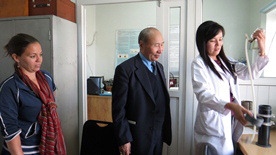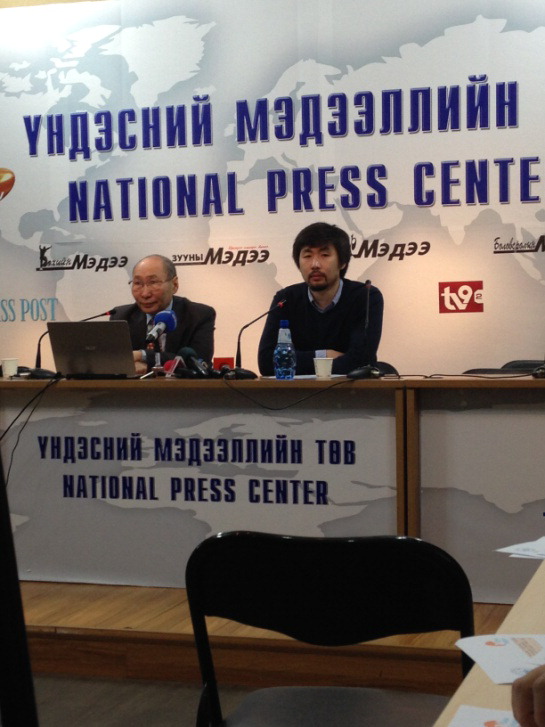|
Cycle 1 (2011 Deadline)
Determining sources and health impacts of particulate matter in Ulaanbaatar City to aid and assess current air pollution mitigation efforts PI: Sereeter Lodoysamba, National University of Mongolia U.S. Partner: Christa Hasenkopf , University of Colorado
Project Dates: June 2012 - July 2015 Project Overview  | | Prof. Sereeter Lodoysamba (center) with U.S. partner Dr. Christa Hasenkopf (left) supervising one of the students. | The air quality in the capital city of Mongolia, Ulaanbaatar, is some of the worst in the world, with particulate matter (PM) levels some 17 to 35 times levels recommended by the World Health Organization.
Such high PM levels are due to the natural geography of Ulaanbaatar, which is situated between two mountain ranges, the high concentration of the population that use traditional stoves to heat poorly insulated tents, and the subarctic climate that requires indoor heating up to nine months out of the year. Donor organizations such as the Millennium Challenge Corporation and the World Bank have taken several air pollution mitigation measures in conjunction with the Mongolian government, including selling more efficient stoves and offering cheap, alternative fuels. Despite these efforts, at the time this project began, there was not a robust method of monitoring the progress of these actions, in terms of air pollution concentrations or health impacts.
The researchers performed continuous measurements over an entire year at one site in Ulaanbaatar to assess the amount of PM2.5 and PM10 and its source, comparing the data obtained with a similar study conducted in 2008-2009 at the same air quality station. They also assessed the impact of current air pollution mitigation efforts and determined morbidity and mortality due to air pollution via analysis of hospital records, compared to a similar World Bank study. The results from the project were shared widely with the local community and with various Mongolian agencies involved in air pollution mitigation measures.
Final Summary of Project Activities  | | Prof. Lodoysamba (at left) appears at press conference, December 2013. | Researchers sampled PM2.5 and PM10 at the selected site for one year. Their initial findings showed that PM2.5 was two times lower than the comparative study. The project team analyzed more than 130 air pollution samples using x-ray fluorescence spectroscopy at the National University of Mongolia to analyze how much pollution is coming from ger stoves versus coal-fired power plants. The team sent samples to the Geophysical and Nuclear Sciences, GNS Science, National Isotope Centre, New Zealand to check their analysis.
The researchers trained medical staff at a family health center to collect data for one year to assess the health impact of air pollution. Preliminary results showed the total number of for respiratory and cardiovascular disease was decreased by 15% after the intervention to reduce pollution.
The PEER project team also helped develop curriculum for a new Master’s degree program at the National University of Mongolia on environmental pollution control and management that is cross-departmental and stressed interdisciplinary techniques.
The team received a significant research grant from local company Oyu Tolgoi to automatically post PM2.5 air pollution data to social media platforms. The PEER project team presented their work at 14 international conferences, as well as to Mongolian and U.S. government representatives. The PI was invited to give a speech to the Mongolian Parliament Standing Committee on smoke pollution mitigation. The team also gained additional data from new collaborations with UB City Air Quality and National Air Quality Agency.
Publication
Sarath K. Guttkunda, Sereeter Lodoysamba, Baldotj Bulgansaikhan, Batdorj Dashdondog. 2013. Particulate Pollution in Ulaanbaatar, Mongolia. Air Quality, Atmosphere and Health 6: 589–601. https://doi.org/10.1007/s11869-013-0198-7
Preliminary results of Dr. Lodoysamba’s work can be found at wiki.ubairpollution.org and daily air quality measurements are available via both Facebook and Twitter.
| 




